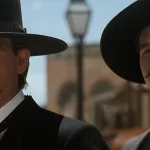Inside Outside, by Scott Nye
The impression that I gather is out there regarding any new Jean-Luc Godard film (to the extent to which such things even exist in the general consciousness) is that it will be a whole lot of work. And, indeed, Goodbye to Language (Adieu au langage), his latest essay-esque film (and his first in 3D), is packed to the gills with socialist philosophy, reflections on the history of the medium, and questions as to the true compatibility of men and women. These topics have intrigued and provoked him since even his short film days, and it doesn’t appear he’s found much closure, nearly sixty years later. All are worthy of continued discussion in connection to the artist.
But what I first want to propose is this – Goodbye to Language is a flat-out awesome spectacle.
In the traditional 3D set-up, you place two cameras side-by-side, one for each eye. They create two images that differ only slightly from one another that, when layered and viewed with the correct glasses, form the illusion of a three-dimensional image. Godard establishes that language quickly and efficiently, while also nodding to the ways in which he’ll exploit the format, with a simple explanatory card in which “2D” is written on the middle layer, with “3D” written on a title card and projected far in front of it. He shows us a few actors in standard spaces with the 3D used to represent the relation between the two, all very familiar to anyone who’s seen Prometheus or any other live-action 3D movie. Water, in particular, has rarely looked more lush and expansive onscreen.
And then he just abandons to rulebook.
Just because you have two cameras representing two eyes, after all, that doesn’t mean they need to cohere at every moment. So you have shots that wildly extend the limbs of his actors or distort reflections by layering them in such a way that you can no longer tell which object is closest or furthest. And if you have two cameras, that means you can use two totally distinct images. His most bravura moments “separate” the frame, allowing one camera to pan over while the first stays stationary, creating images that at once overlap yet remain discreet. The experiments are so numerous, so unexpected, and often so inexplicable that it’s tough to catalogue them after a single viewing. The total effect is so unlike anything I’ve seen from even the avant-garde, let alone the mainstream. The image seems to literally be washing over the audience, as a swirl of lights and colors dance above the heads of the rows before you. There are passages that suggest what Brakhage might have done with this technology. And yes it’s audacious and confounding and, hey, maybe not always explicating some grand theme or “message,” but it’s totally, uniquely awe-inspiring, jaw-dropping, singularly spectacular.
Godard’s ability to play with distance is importance, as distance is his recurring theme. The distance between men and women, between the state and its people, between society and culture, between the audience and the film he’s made. One of the more legible storylines in Goodbye to Language involves a man (Kamel Abdeli) and a woman (the riveting Héloise Godet), often naked, speaking across purposes. Not an unfamiliar narrative for him. The effort to make oneself understood can sometimes be a strain, seeming to distort your own image of yourself, much like how Godard uses 3D to distort the body. Never mind the “separated” images, which should how people can at once occupy the same, yet totally distinct, space.
There is, too, a distance between the interconnectedness of technology and the rather banal pursuits we use it for, as Godard observes people fiddling about on their iPhones, ignoring the gorgeous classical music on the soundtrack. They are also ignoring other people on the street, but that rather common observation seems too small for Godard. He seems more flummoxed by the modesty of man’s pursuits when given such tremendous resources.
To an extent, Goodbye to Language is a sort of diary for Godard, right down to the fact that an entire component of the film is more or less home videos of his own dog. Roxy, as he is called in the film, does eventually figure into the man and woman’s story, but this aspect of the film simply would not exist were Godard not a dog lover. But it shows a range of concerns for the filmmaker, using his medium to rail against what angers him, meditate on what inhibits him, revel in what brings him joy, and explore what frontiers may yet remain open in this aging art form.
Does it all cohere? Perhaps. If so, it’s not in the ways one might expect. He famously said, “To me style is just the outside of content, and content the inside of style, like the outside and the inside of the human body – both go together, they can’t be separated.” Godard’s dialogue and voiceover, more direct than ever, can seem to leave little room for the style to elaborate. But there’s so much on the outside that enriches the inside. Godard pushes the boundaries of both the form and the capacity of his audience to receive it. My eyes strained for hours afterward. The extent to which physical exertion could be a measure of artistic success is debatable, but when it comes as a result of having so much to look at and so many new ways of seeing, it may just be that our bodies need to catch up. And at a cool 70 minutes, it’s more a sprint than a marathon. It’s an astounding, exhilarating experience, undoubtedly the cinematic event of the year, and I cannot wait to revisit it.




























A great review. I couldn’t agree more with the film being a magnificent spectacle. It almost manifests in the memory after viewing as a dream or some kind of unconscious event. It presents a completely unique image of the world and take on cinema. And its so great to read a review so passionate about how innovative Godard can still be.
Not only did my eyes, but my ears strained after viewing. A completely anomalous experience.